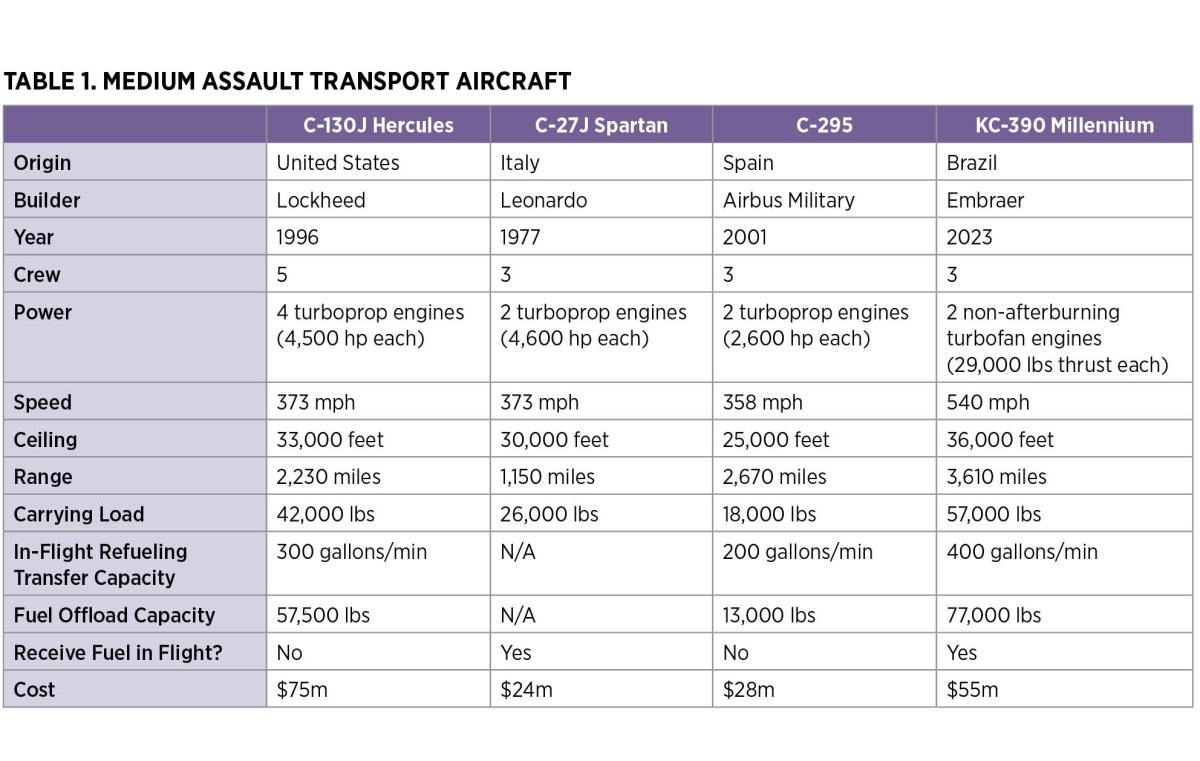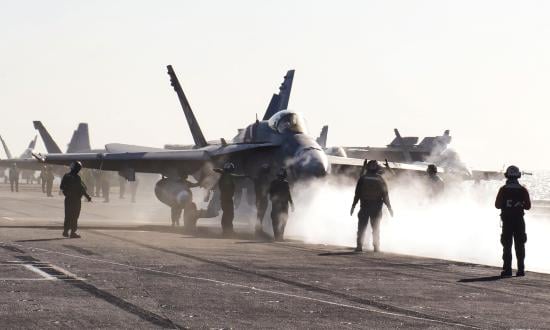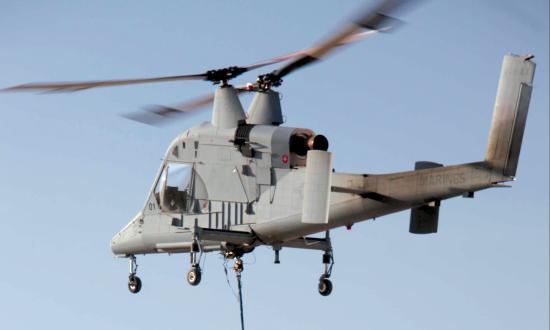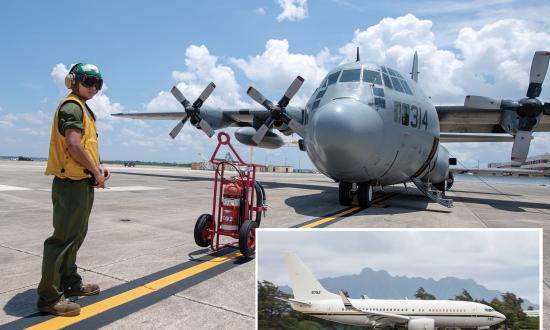The Marine Corps’ Installations and Logistics 2030 provides guidelines for “the organizations that support force generation, power projection, employment, and sustainment of ready Marine Forces.”1 It reiterates that “among the seven warfighting functions, logistics most dictates the tempo of operations and the operational reach of a unit. No other warfighting function more profoundly affects our ability to persist in contested spaces.”
The Marine Corps’ go-to fixed-wing transport aircraft is the Lockheed KC-130J Hercules, the latest version of an aircraft that first flew in 1954. Its production line is the longest running one for a miliary aircraft anywhere in the world, and all versions taken together make up about 21 percent of military transports operating worldwide. Lockheed has squeezed just about all it can from this four-engine, turboprop design.
Over the past decade, technologies have evolved that now offer designs with lower acquisition costs, higher airspeed and altitude limits, and lower projected lifecycle costs.
The Marine Corps has one reserve and four active Hercules squadrons, whose missions include aerial and rapid ground refueling, personnel and cargo transportation, medical evacuations, parachute insertions, and emergency resupply into unimproved landing zones. They can refuel helicopters and tiltrotor and fixed-wing aircraft in support of tactical missions, training operations, or ferry flights.2 Three squadrons have reached their force level of 17 aircraft, with one more to reach it in fiscal year (FY) 2026 and the other in FY27. But compared with other transport and tactical refueling aircraft, the Super Hercules is slow and short-legged and has payload capacities that are too small for the challenges the Marine Corps expects to face in the future.
As the Marine Corps evolves, the challenges of conducting distributed operations in contested logistics environments increase significantly. Table 1 provides a look at how the C-130J Hercules stacks up against possible alternatives.
The Best Option
Among currently operational aircraft in the medium tactical transport category, the C-27J and the C-295 are too small, too slow, too limited in capacity, and/or too limited in range. Other options, such as the Airbus A400 or Kawasaki C-2, do not quite fill the same roles. Airbus considers the A400 a strategic airlifter, and Kawasaki’s aircraft is much heavier, making it less suitable for unimproved facilities. Both aircraft are also considerably more expensive than either the KC-130J or KC-390. Only one aircraft offers the Marine Corps significant enhancement in all missions.
The Embraer KC-390 Millennium entered service with the Brazilian Air Force in 2019. Portugal began using it in 2023, and it has been selected by the Czech Republic, Hungary, Austria, and South Korea. The Netherlands has placed an order, and Embraer has interest from several other NATO members, as well as countries in Africa and the Indo-Pacific region. The aircraft will integrate into the European Airlift Transport Command, the command center that exercises operational control of the majority of aerial refueling and military transport fleets of seven European Union member states.
With the KC-390, Embraer has departed from the typical turboprop design. While roughly the size of a Hercules, it has a high, swept wing, T-tail configuration and two IAE V2500-E5 turbofan engines. With this design, it can cruise at about 470 knots (540 mph) at an operational ceiling of about 36,000 feet. Embraer says the aircraft also will have the lowest life-cycle cost in the medium airlift market. Much of the technology comes from systems and engineering expertise from the company’s commercial airline business, which builds the popular E-Jet short-to-medium range airliners, with more than 1,600 built to date.3
With its nimble fly-by-wire systems with closed-loop and active side sticks and control surfaces such as spoilers, the KC-390 is quite agile at low speeds. With engines mounted high on its wings, the aircraft should have no problem with degraded landing strips or the issues and expense caused by damage to the six-bladed composite propellers on the Hercules.
The International Aero Engines (IAE) two two-shaft, high-bypass turbofan engines (versus four turboprops on the Super Hercules) offer significant performance and economic benefits, including reduced fuel and maintenance requirements. The IAE 2500 series engines with thrust reversers in their design are installed on the Embraer 190 and Airbus A320 families of aircraft as well as the McDonnell Douglas MD-90. The aircraft’s integrated Onboard Maintenance System keeps track of the aircraft. And the fly-by-wire control system significantly reduces crew workload.
For aerial delivery, its advanced avionics permit the crew to calculate an air release point with excellent precision while the modern cargo-handling and aerial-delivery system (CHADS) offers remote and automatic release of cargo in-flight at both high and low altitudes. Both the internal and external configuration of the aircraft can be quickly and easily changed to facilitate several missions. It is notable that, when looking for a successor to its aging C-130s, the Dutch Ministry of Defense found that the KC-390 was a better choice than the C-130J.4
In September 2022, L3Harris Technologies entered a partnership with Embraer to convert the KC-390 into an “agile tanker” that can fly closer to the front lines in conflict and refuel all types of U.S. and allied military aircraft. Under the agreement, L3Harris plans to develop a refueling boom—to complement its existing buddy stores system—and special military communication equipment on the planes. The aircraft also could be a replacement for the Air Force Special Operations Command’s C-130s, for those in National Guard units, and for allies.
As it is unlikely that the Department of Defense and Congress will approve waivers to the Buy American Act to purchase the aircraft, L3Harris or another contractor probably would have to build the aircraft at a U.S. facility.
The transition to the KC-390, with its ability to quickly reconfigure for another mission, could be a force multiplier for the Marine Corps. It flies faster, carries more cargo for longer distances with lower maintenance and fuel costs, and costs less than the KC-130J. And with its ability to be refueled in flight, it offers combatant commanders the ability to support dispersed operations over the vast distances of the Indo-Pacific or the High North.
As all the development and testing has been completed and with the scale a U.S. manufacturer brings, it could enter production and be available to the Marine Corps as early as FY27.
1. Gen David Berger, USMC, Installations and Logistics 2030 (Washington, DC: Headquarters, U.S. Marine Corps, February 2023).
2. LtGen Mark Wise, USMC, 2022 United States Marine Corp Aviation Plan (Washington, DC: Headquarters, U.S. Marine Corps, 3 May 2022).
3. Gabriel Auraujo, “Embraer Optimistic about Quarters Ahead as Q2 Profit Blows Past Estimates,” Reuters, 14 August 2023.
4. Stefano D’Urso, “The Netherlands Selects the Embraer C-390 as Its New Tactical Cargo Aircraft,” The Aviationist, 21 June 2021.








